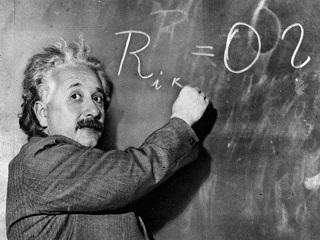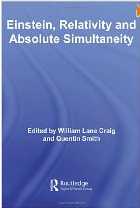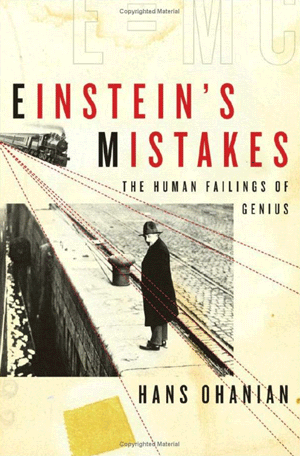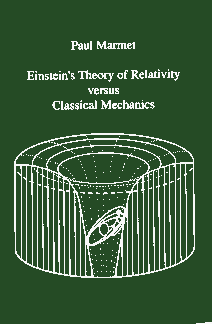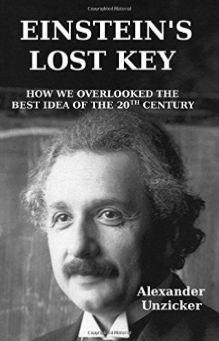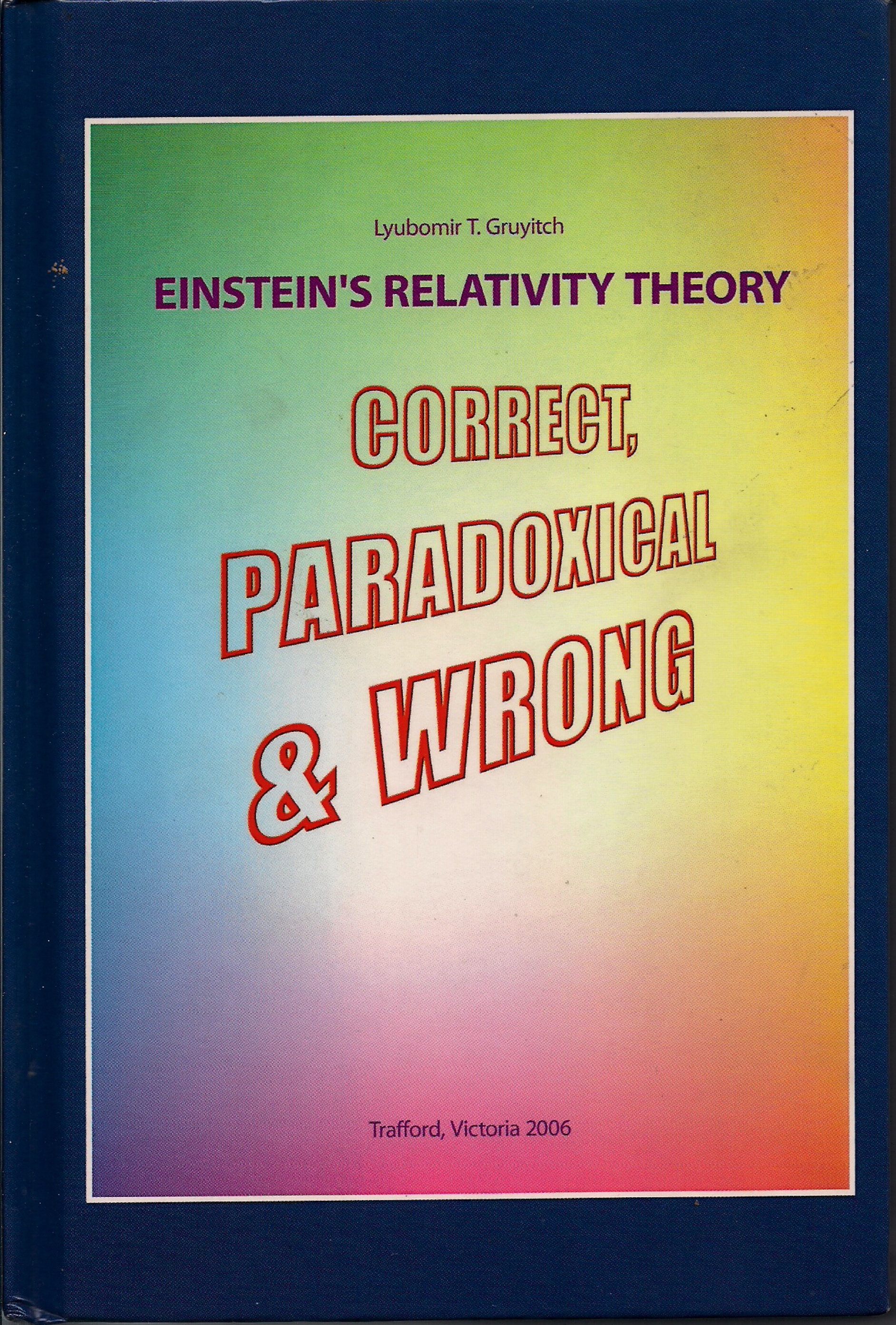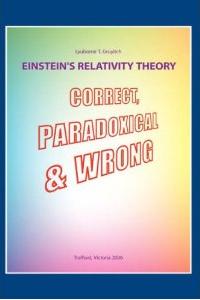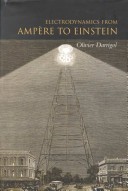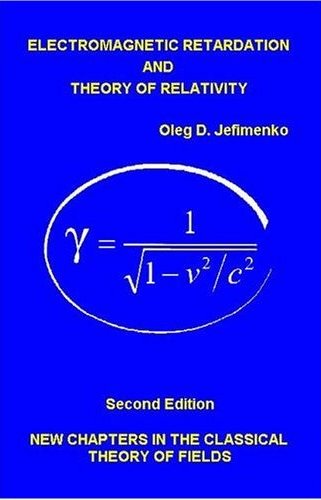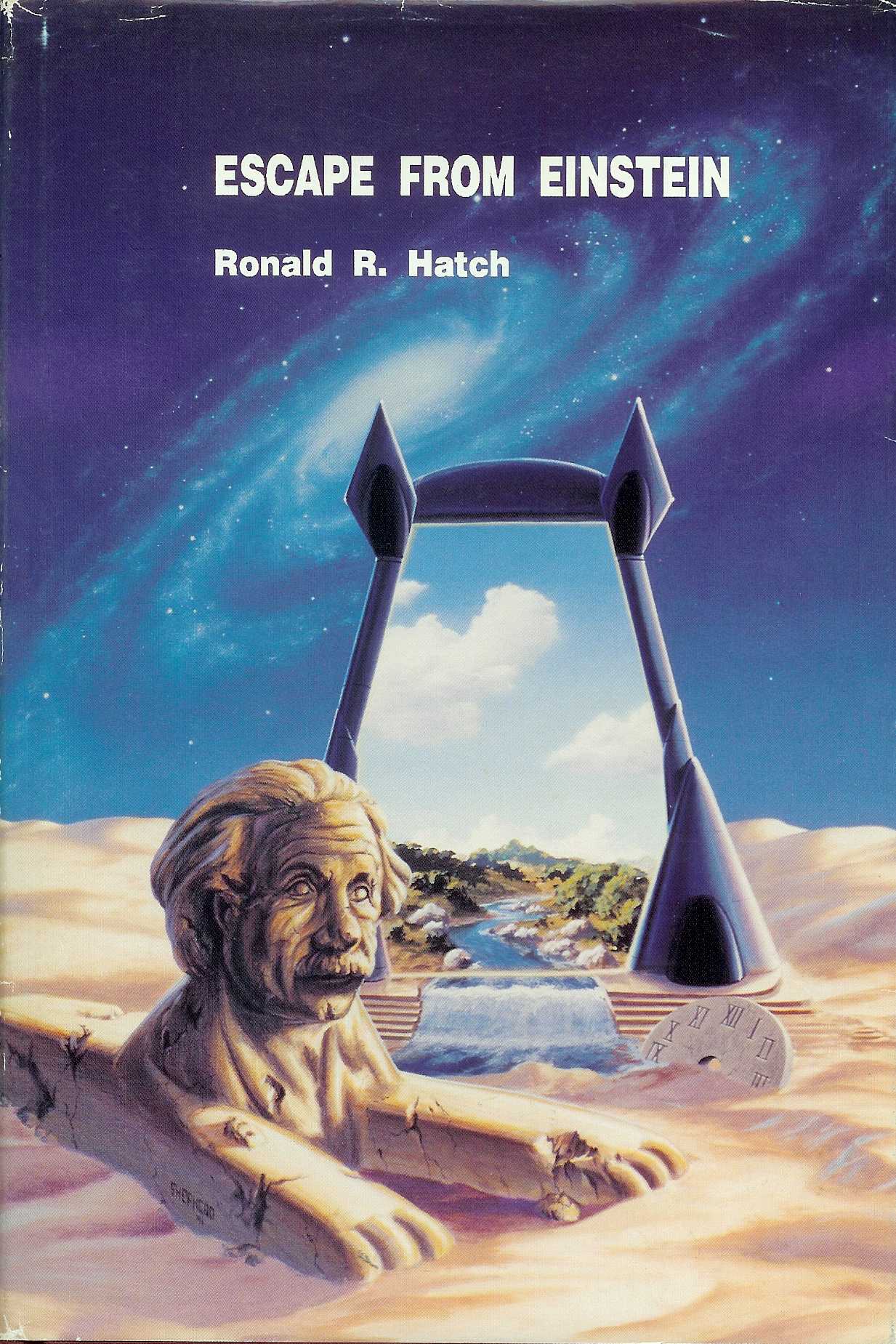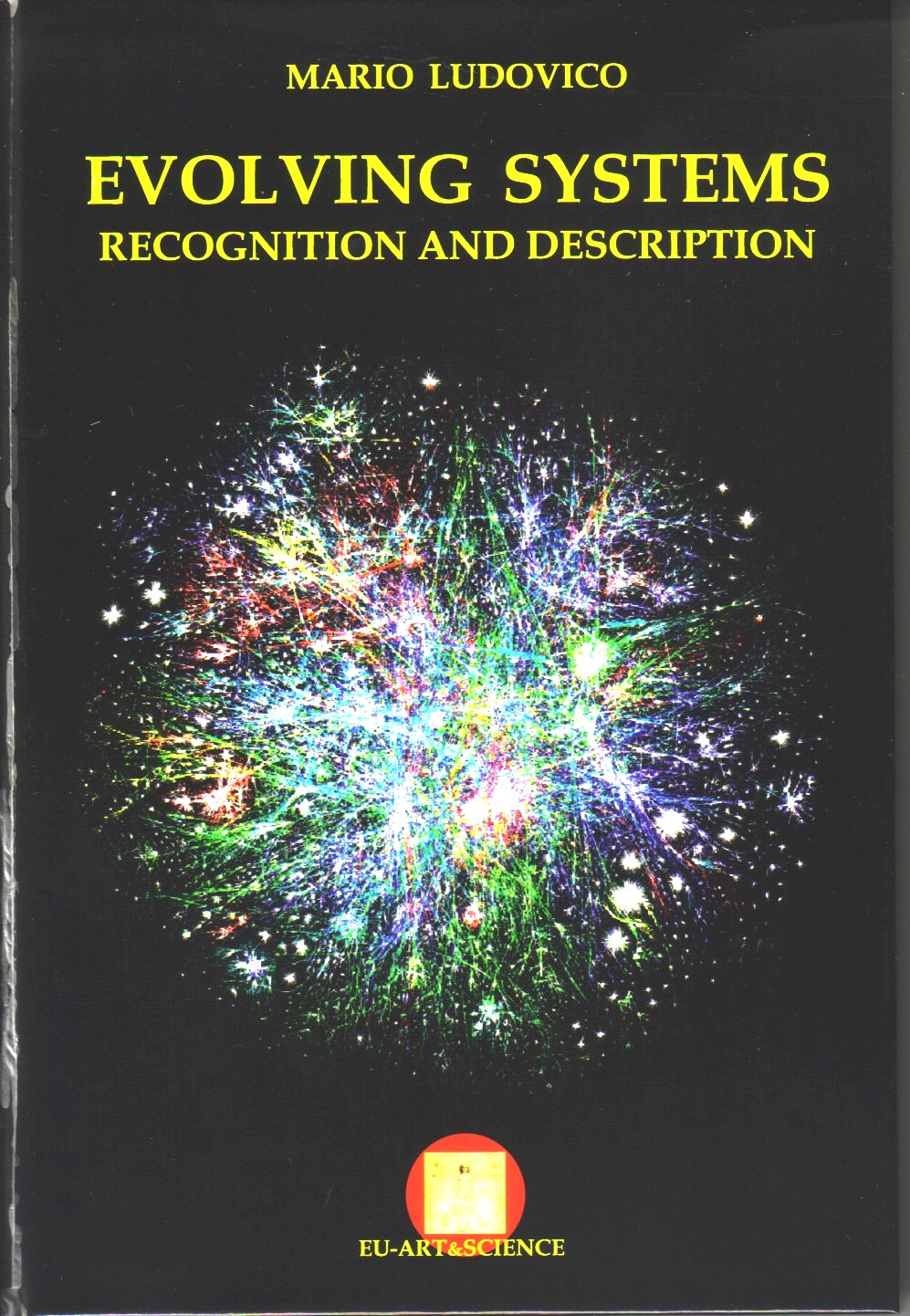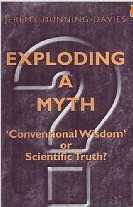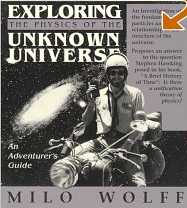(See right-hand panel for a full list of scientists, papers, and books)
Pages: 164
Publisher: Enrique Morales-Riveira
Year: 2000
ISBN: 958332020X
ISBN: 978-9583320200
This book is quite controversial and very surely will raise lively discussions and deep intellectual restlessness in lay circles, as well as at the level of the international scientific community, because the author?s discoveries return to classical physics a lost symmetry, removing it from some marshy and moving lands through which it has been traveling throughout the past 85 years.
This book is specially conceived for a wide audience of people with genuine and enthusiastic interest for these topics, but not necessarily with scientific training. The author has attempted to make his work understandable to a lay reader having only a casual background in mathematics and physics, sparking his(her) interest and encouraging him(her) to further explorations into the field of relativity and gravitation.
The topics and discussions of the book are highly organized and structured, following a planned logical sequence and using figures to make everything easy and pleasant for the reader, looking for simplicity and meaning. The language used is deprived of technical jargon, and all explanations, and demonstrations, are without mathematical difficulties.
This book certainly could on-set what probably will be the most exciting and important scientific controversy of the 21st Century, which is none other than the epistemological absurdity of the still unproven current fundamental scientific postulates about time, space energy and matter; bringing Physical Science to the next plateau. This unique book has the potential to become a historical scientific document for generations to come.
View count: 1
Pages: 233
Publisher: Milan R. Pavlovic
Year: 2000
Websites: milanrpavlovic.freeservers.com users.net.yu/~mrp/index.html
Download and read it now
The main subject of this book is a critical analysis of the special theory of relativity as a scientific theory, which, above all, is concerned with questions connected with time, space, mass and energy and with the relationship between time and space, and mass and energy. According to the theory of relativity time and space are mutually dependent and the contraction of space and the dilatation of time originate with motion as real physical processes.
The book demonstrates that the dilatation of time and the contraction of space are not real physical processes, but nothing more than mathematical games which are not in accord with the laws of physics and even with the declared principles of the theory of relativity. In addition to that it is shown that Einstein did not derive the formula for mass in motion and the formula for the mutual connection between mass and energy, and also that they cannot be derived by correct relativistic procedure. These formulas have been derived here, on the whole, by correct classical procedure. It has finally been demonstrated that they are classical formulas, not relativistic. In this way it is demonstrated that the special theory of relativity and the general theory of relativity, which is based upon the special theory of relativity, are only an unsuccessful attempt to generate a scientific theory.
The claim that mass is transformed into energy through an annihilation of an electron and a positron, as well as a transformation of energy into mass through a creation of the pair electron - positron, are contested. In connection with this it is given a hypothesis on the existence of new neutral particle called the elpotrin, which is formed at collision of an electron and a positron. A new explanation of the red shift in the radiation spectrums of distant galaxies disputes the Hubble's hypothesis about dispersion of galaxies and the existence of the big bang. Besides that the origin of the primary cosmic rays and their enormous energies are explained.
The existing classical and relativistic explanations of aberration are disputed. The hypothesis about the existence of the earth's ether and the sun's ether, whose relative motion causes the phenomenon of aberration is presented. In connection with this a new type of the interferometer is invented and described, with which it is possible to confirm or to deny the existence of the earth's ether. New explanation of the Fizeau's test and the theory of light propagation through moving transparent mediums are also given.
Table of Contents: http://users.net.yu/~mrp/contents.html
View count: 1
Pages: 240
Publisher: Routledge
Year: 2007
ISBN: 0415701740
ISBN: 978-0415701747
Einstein, Relativity and Absolute Simultaneity is an anthology of original essays by an international team of leading philosophers and physicists who, on the centenary of Albert Einstein?s Special Theory of Relativity, come together in this volume to reassess the contemporary paradigm of the relativistic concept of time. A great deal has changed since 1905 when Einstein proposed his Special Theory of Relativity, and this book offers a fresh reassessment of Special Relativity?s relativistic concept of time in terms of epistemology, metaphysics and physics. There is no other book like this available; hence philosophers and scientists across the world will welcome its publication.
Contents:
- Introduction 1
- 1 William Lane Craig: The Metaphysics of Special Relativity: Three Views 11
- 2 Craig Callender: Finding "Real" Time in Quantum Mechanics 50
- 3 Quentin Smith: A Radical Rethinking of Quantum Gravity: Rejecting Einstein's Relativity and Unifying Bohmian Quantum Mechanics With a Bell-neo-Lorentzian Absolute Time, Space and Gravity 73
- 4 Antony Valentini: Hidden Variables and the Large-Scale Structure of Space-Time 125
- 5 Tim Maudlin: Non-Local Correlartions in Quantum Theory: How the Trick Might be Done 156
- 6 Franco Selleri: The Zero Acceleration Discontinuity and Absolute Simultaneity 180
- 7 Tom Van Flandern: Global Positioning System and the Twins' Paradox 212
- 8 Michael Tooley: A Defense of Absolute Simultaneity 229
- 9 Richard Swinburne: Cosmic Simultaneity 244
- 10 Thomas L. Crisp: Presentism, Eternalism and Relativity Physics 262
- 11 John Lucas: The Special Theory and Absolute Simultaneity 279
- Index 291
This discovery does not let the author rest any more. He corrects Einstein?s errors and searches for that which holds together the world. The next surprise is that there appears to be quite another theory of the world ? with a new view of space and time and unbelievable solutions for the topical problems of physics. Not only the basic questions can be answered such as the origin of our universe and the flow of time, also the cause for the puzzling ?dark energy? and the ?missing link? between the theories of relativity and quantum mechanics become visible. It is as if the nature only now reveals her most inner secrets.
With this knowledge, this popular-scientific, but at the same time profound book describes what the world "really" consists of and what kind of "rules" it has for us. Since ? as the author points impressively ? now principle questions of economics, of our society and even of psychology can also be answered. This is the first book to show a Grand Unifying Theory, and it can help to revolutionize the whole of science and put it finally on a uniform foundation.
Pages: 256
Publisher: W. W. Norton
Year: 2008
ISBN: 0393062937
ISBN: 978-0393062939
Fresh insights into aspects of Einstein we don't usually consider: his mistakes and the role they played in the discovery of his theories.
Although Einstein was the greatest genius of the 20th century, many of his ground-breaking discoveries were blighted by mistakes, ranging from serious misconceptions in physics to blatant errors in mathematics. For instance, Einstein's first theoretical proof of the famous formula E = mc? was incomplete and only approximately valid; he struggled with this problem for many years, but he never found a complete proof (better mathematicians did). In this provocative forensic biography, Hans Ohanian dissects this and other mistakes and places them in the context of Einstein's turbulent life and times. Einstein was often navigating in a fog of irrational and mystical inspirations, but his profound intuition about physics permitted him to reach his goal despite?and sometimes because of-the mistakes he made along the way. Einstein's uncanny ability to use his mistakes subconsciously as stepping-stones toward his revolutionary theories was one hallmark of his genius. 25 illustrations.
A close examination of Einstein's work, emphasizing the errors and wrong turns that even colleagues overlooked.Ohanian, a former editor of the American Journal of Physics, proceeds through the years, rarely missing a paper, speech, interview or controversy. The author covers many fields, because Einstein made not one but several breakthrough discoveries; his Nobel, in fact, was for the photoelectric effect, not relativity. Einstein admitted that mathematics was not his strong suit, but beyond the torrent of errors in that area, Ohanian also finds mistakes in physical assumptions that range from oversimplification to outright nuttiness. Max Planck, working as a journal editor, read the unknown Einstein's revolutionary 1905 paper on special relativity and found a major error in the discussion of relativistic mass. Recognizing the paper's importance, Planck approved it and later worked out a correct recalculation for which he has never received credit. Because of Einstein's fame, everyone believes he discovered the equation linking mass to energy. In fact, other physicists knew of it for years, and his 1905 proof was incomplete; once Max Von Laue produced a complete proof in 1911, Einstein adopted it. Ohanian emphasizes two absolute laws of research. One: If a scientist makes a brilliant discovery, everyone forgives mistakes he made along the way. Two: If he becomes a scientific superstar, he gets credit for everything in his field. Thus Einstein gets credit for everything connected with relativity, including earlier discoveries and those of colleagues who improved his work. Dennis Overbye's Einstein in Love (2000) gives the best popular account of his science, while Walter Isaacson's bestselling Einstein (2007) is the best on his life. Ohanion's book delves more deeply into physics and into Einstein's thought processes, so readers will have to pay close attention.A sophisticated overview of modern physics, including more of Einstein's missteps than readers usually encounter.
View count: 1
This book, written in Swedish the same year Einstein received the Nobel Prize for the Photoelectric Effect, contains much of the material in Nordenson's expanded English book, Relativity, Time and Reality, published forty-seven years later. It presents a very detailed analysis of how Einstein used (or abused) the concept of time. Einstein's use of different concepts of time without real definitions and relations to reality means, according to Nordenson, that his theories are inconsistent and not real theories. A copy is available from Stockholm University Library.
Pages: 200
Publisher: Newton Physics Books
Year: 1997
ISBN: 0921272189
ISBN: 978-0921272182
Websites: www.newtonphysics.on.ca
The aim of this book is to demonstrate that using "Conventional Wisdom" and "Conventional Logic", classical physics can explain all the observed phenomena attributed to relativity. The arbitrary principles of Einstein's relativity are thus useless.
It is very important to recognize the fundamental importance of the principle of mass-energy conservation. It took thousands of years of development for scientific thought to finally reject the magic of witchcraft. During the nineteenth century, scientists became convinced that matter cannot be created from nothing. Conversely, matter cannot be destroyed into nothing. It seems that even Einstein believed this, since he is the one who, at the beginning of the twentieth century, introduced the equation E = mc2 implying mass-energy conservation. However, he later developed general relativity which is not compatible with that principle. Indeed, according to Straumann, the "general conservation law of energy and momentum does not exist in general relativity". Twentieth century science moved backward in accepting again the magical creation of matter or energy from nothing, even if this is hidden in complicated mathematics.
Contrary to what Einstein did, all the demonstrations in this book are compatible with the principle of mass-energy and momentum conservation. Using classical mechanics, we demonstrate that length contraction is a real physical phenomenon. We examine how this leads to the Lorentz equations. Then, we show how classical principles are sufficient to explain the advance of the perihelion of Mercury and derive Einstein's equation. The fundamental reason for this advance is illustrated with a classical apparatus. We also study the Lorentz transformations in three dimensions and the Doppler phenomenon. Then we see how the problems brought by the relativity of simultaneity and by the principle of equivalence can be explained using conventional logic. We also show how classical mechanisms produce perturbations in the internal structure of atoms and molecules. Finally, we show that the presence of intense gravitational potentials leads to degenerate matter corresponding to Schwarzschild's black holes.
Einstein's relativity principles are not needed in these demonstrations. The only principles used are the ones already existing in classical mechanics. All the solutions are based on a physical model compatible with conventional logic.
Einstein's theory of relativity is a mathematical model which is not compatible with the physical models described in classical mechanics since it is not compatible with the principle of mass-energy conservation. This is a well-known fact. It is claimed that the theory of relativity is so advanced that it is not possible to give a Newtonian physical description of it. It is also often argued that abandoning classical scientific concepts leads to a scientific revolution. It is erroneous to believe that a new scientific revolution must abandon the fundamental principles brought up by Newton's classical mechanics and logic which gave birth to all our knowledge in physics.
As stated in several papers, Einstein's relativity implies "New Logic" which contradicts "Conventional Logic". Einstein's theory implies that because we can find some arbitrary mathematical relationships that fit some experiments, we must abandon conventional logic. History reports some rudimentary scientific models that also fitted experiments but which were based on nonsense. Those models were rejected. A new scientific revolution based on "New Non Conventional Logic" can lead to a scientific disaster or to a dead end. No scientific concept can be so advanced that it is no longer compatible with logic.
Einstein's relativity assumes new mathematical hypotheses and ignores completely the concept of models to describe physical reality. Einstein supposed that time and space can be distorted and that simultaneity is relative but he did not give any serious description of what this really means physically. In Newton's time, physical descriptions of phenomena were accompanied by mathematical equations giving quantitative predictions corresponding to those physical descriptions. Einstein's relativity claims that nature can be described with mathematical equations without any physical description. There is a complete abandon of all the physical models that made physics understandable in Newton's time.
Our main argument here is not whether Einstein's hypotheses are true or not. We believe that if Einstein's hypotheses are correct, they must correspond to a real physical mechanism. Such a real mechanism is described in this book using classical mechanics and classical logic.
With Einstein's new logic, contradictory results have appeared. For example, Gerald Feinberg developed the theory of tachyons which move faster than the speed of light. There are also mathematical models calculating wormholes, strings, multidimensional space, superluminal objects, time reversal and even time lines. Certainly, these claims do not make sense when we use conventional logic.
An expert in Einstein's relativity is described as an expert in the mathematics of relativity. Since the conventional wisdom of classical physics is not used in relativity, an expert in relativity is not trained to deal with Newtonian logic. Consequently, this book on relativity will be much more easily understood by an expert in classical physics since he or she already knows the mathematics and understands the classical mechanisms involved. It might appear surprising to some readers that relativity can be explained with classical principles. However, they will never escape out of their preconceived notions and learn how this is done unless they carefully read this book. - From the Preface.
Book Review: Einstein's Theory of Relativity versus Classical Mechanics by Dr. Thomas E. Phipps Jr.
Pages: 236
Publisher: CreateSpace Independent Publishing Platform
Year: 2015
ISBN: 978-1519473431
One hundred years after the completion of the General Theory of Relativity, conferences, meetings, and celebrations are taking place all around the world. Yet a decisive consideration on the subject by Albert Einstein has completely fallen into oblivion. Already in 1911, he held the key to an even greater discovery in his hands: a theory concerning the variable speed of light that would have explained the origin of gravity by referring to distant masses in the universe. Eventually, the consequences for modern cosmology would be revolutionary: the picture of an expanding universe and the Big Bang would need to be revised. Sadly, Einstein's ingenious idea came twenty years too early. For it took until the 1930s before the true size of the universe was revealed, which would have confirmed his formula about the variable speed of light. Due to a series of accidents, the theory remained practically unknown, although the Nobelists Erwin Schrödinger and Paul Dirac had worked on similar ideas. Einstein's Lost Key is a description of relativity comprehensible for lay people, a vividly exposed history of science, and a serious, though controversial input for modern research. Dr. Alexander Unzicker is a German physicist and award-winning science writer. His books Bankrupting Physics and The Higgs Fake have generated controversy in the physics community. With Einstein’s Lost Key, Unzicker gives an account of his long-lasting pursuit of Einstein's ideas.
KIRKUS REVIEWS: ...the author’s ideas are engaging and he presents them well. [...] turns into a screed against the scientific establishment.
Pages: 316
Publisher: Trafford Publishing
Year: 2006
ISBN: 1412202116
ISBN: 978-141220211
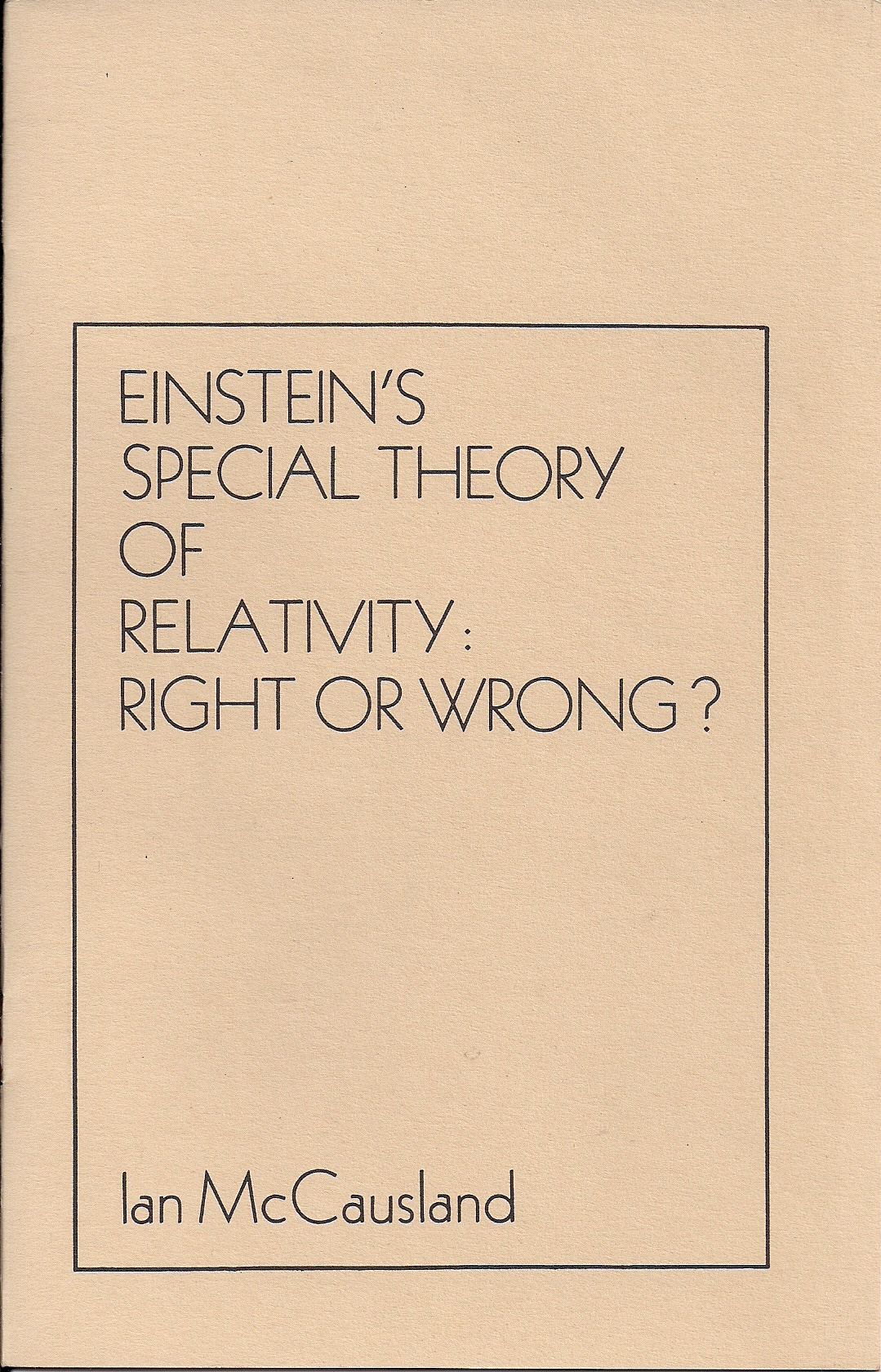
View count: 1
Pages: 352
Publisher: Electret Scientific Company
Year: 1997; 2nd ed 2004
ISBN: 0917406249
ISBN: 978-0917406249
Websites: www.as.wvu.edu/coll03/phys/www/OJ/jefimenk.html
As Professor Jefimenko shows, the theory of electromagnetic retardation leads to, and duplicates, many electromagnetic relations that are customarily considered to constitute consequences of relativistic electrodynamics. Much of the first part of the book is devoted to establishing a bridge between the theory of electromagnetic retardation and the theory of relativity. In the second part of the book, Chapters 6 to 11, all the fundamental equations of the special relativity theory, including equations of relativistic electrodynamics and mechanics, are derived in a natural and direct way from equations of electromagnetic retardation and from electromagnetic force and energy equations without any postulates, conjectures, or hypotheses. As a result, the theory of special relativity acquires a new physical and mathematical base and becomes united with Maxwellian electromagnetism into one simple, clear, and harmonious theory of electromagnetic phenomena and mechanical interactions between rapidly moving bodies. Numerous well-chosen original illustrative examples demonstrate various applications of the relativistic electrodynamics and relativistic mechanics developed in this part of the book.
The new approach to the formulations of the theory of relativity presented in this book makes it necessary to reexamine the conventional interpretation of some of the key aspects of the special relativity theory. One of the most significant results of this reexamination is that, although the idea of Lorentz length contraction played an important part in Einstein's approach to the formulation of the theory of relativity, this idea is not an integral part of the theory of relativity itself. Another equally significant result of this reexamination, based on an analysis of a dozen elementary electromagnetic clocks, is that the rate of the moving clocks depends both on the velocity and on the construction of the clocks, so that although all the clocks examined in the book run slow when in motion, only some clocks conform to Einstein's time-dilation formula; others do not.
Finally, the novel approach to the formulation of the special relativity theory developed in this book leads to the conclusion that gravitational phenomena are subject to essentially the same relativistic relations as are the electromagnetic phenomena. Based on this conclusion, a covariant formulation of Newton-Heaviside's gravitational theory is developed and presented in the last chapter of the book.
An Appendix to the book contains an analysis of the physical nature of electric and magnetic forces and presents a novel interpretation of the "near-action" mechanism of electromagnetic interactions.
Pages: 299
Publisher: Longmans, Green
Year: 1957/1959
ISBN: B0000CJT5B
ISBN: B0000CKF4Y
ISBN: B0000EGNLD
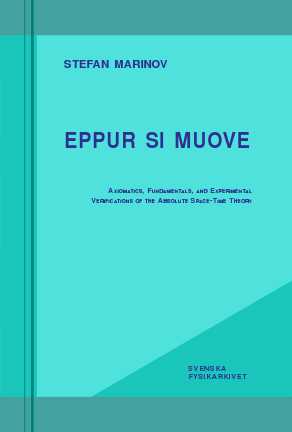
View count: 1
Pages: 200
Publisher: East-West Publishers, Graz
Year: 1977 / 4th ed 2008
ISBN: 978-9185917020
Websites: www.ptep-online.com/index_files/books.html en.wikipedia.org/wiki/Stefan_Marinov
Pages: 245
Publisher: Meppen: Ewert
Year: 1991/1995
ISBN: 389478007X
ISBN: 978-3894780074
Pages: 232
Publisher: Kneat Kompany
Year: 1992
ISBN: 0963211307
ISBN: 978-0963211309
Einstein's fame can, to some extent, be ascribed to the fact that he originated a theory which, though contrary to common sense, was in remarkable agreement the experimental data. Ron Hatch claims there is increasingly precise data which contradicts the theory. But he does not stop there. He offers an alternative - an ether guage theory, which offers an unparalleled, common-sense explanation of the experimental data. The new theory is distinguished by:
- a return to time simultaneity, even though clocks (mechanical and biological) can run at different rates
- the replacement of the Lorentz transformations with gauge transformations (scaled Galilean transformations)
- a unification of the electromagnetic and gravitational forces
- a clear explanation of the source of inertia
- a clear and consistent explanation of the physics underlying the equivalence principle
In addition to the above, a comprehensive review of the experimental record shows that the new ether guage theory agrees with experiment better than the special theory. This releases everyone from the necessity of accepting a nonsensical theory which denies the common, ordinary sense of elapsed time. Rather than curved space, the ether guage theory postulates an elastic ether. This results in relatively minor modifications to the general theory mathematics - but with significant interpretational differences. - From the endpiece
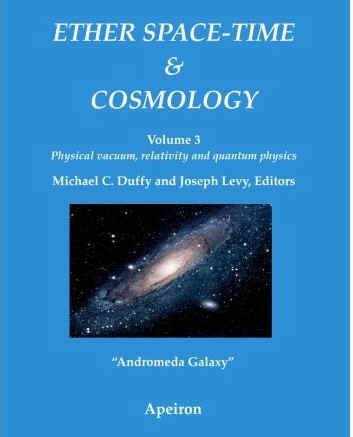
View count: 1
The
?Ether space-time & cosmology? program comprises several volumes designed
to inform the physics community of the resurgence of the ether in modern
science. The reality of the concept and its importance, which were denied at
the beginning of the 20th century, aroused renewed interest by the
end of the 20th century and the beginning of the 21stcentury.
Research
undertaken during the last 20 years has confirmed the existence of physical
properties within space, even where it is devoid of ordinary matter. In
addition to the well known properties of permittivity, permeability and the
ability to transmit electromagnetic waves, more recently other features have
been associated with the concept of space. These include the Casimir Effect and
a significant amount of energy. These properties attributed to the vacuum, which
are universally recognized, strongly support the necessity of a substratum; however,
the substratum as such has been most generally denied and its role ignored, such
that it has not been investigated to the extent it ought to have been.
Ether
space-time & cosmology proposes to fill this gap, and to restore to the ether the attention it deserves. One of the
objectives of this series of books is to progressively disclose its properties.
The introduction of the ether, as a key actor in physical processes, will
resolve a number of paradoxes in 20th century physics, which arose
because it has been dismissed.
This
third volume, like the previous ones, presents articles, written by experienced
physicists, dealing with different aspects of the ether concept. Topics
relating to quantum theory, dark energy and dark matter and review of the basic
assumptions of relativity are addressed, among others.
Ether
space-time & cosmology? is a development of the Physical Interpretations of
Relativity Theory conferences, which began in

View count: 1
Publisher: Apeiron
Year: 2008
ISBN: 1873694105
Websites: redshift.vif.com/book_catalog.htm
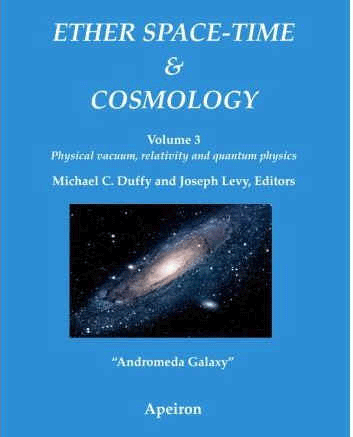
View count: 1
Pages: 464
Publisher: Apeiron
Year: 2010
ISBN: 9780986492600
Websites: redshift.vif.com/book_catalog.htm
The ether space-time & cosmology program comprises several volumes designed to inform the physics community of the resurgence of the ether in modern science. The reality of the concept and its importance, which were denied at the beginning of the 20th century, aroused renewed interest by the end of the 20th century and the beginning of the 21st century.
Research undertaken during the last 20 years has confirmed the existence of physical properties within space, even where it is devoid of ordinary matter. In addition to the well known properties of permittivity, permeability and the ability to transmit electromagnetic waves, more recently other features have been associated with the concept of space. These include the Casimir Effect and a significant amount of energy. These properties attributed to the vacuum, which are universally recognized, strongly support the necessity of a substratum; however, the substratum as such has been most generally denied and its role ignored, such that it has not been investigated to the extent it ought to have been.
Ether space-time & cosmology proposes to fill this gap, and to restore to the ether the attention it deserves. One of the objectives of this series of books is to progressively disclose its properties. The introduction of the ether as a key actor in physical processes, will resolve a number of paradoxes in 20th century physics, which arose because it has been dismissed.
This third volume, like the previous ones, presents articles, written by experienced physicists, dealing with different aspects of the ether concept. Topics relating to quantum theory, dark energy and dark matter and review of the basic assumptions of relativity are addressed, among others. Ether Space-Time & Cosmology is a development of the Physical Interpretations of Relativity Theory conferences, which began in 1988 in London, and which now take place in London, Moscow, Calcutta and Budapest. Details of these conferences, including names and addresses of contacts and sponsors, are given on the PIRT web site.
Pages: 194
Publisher: EU - Art & Science Publications
Year: 2013
ISBN: 978 83 935247 6 1
Websites: www.ccsdruk.pl www.mario-ludovico.com www.lifeenergyscience.it/journal.htm
Download and read it now
The book's version presented here is an abridged English edition (104 pages instead of 194) of a theory that was originally published in year 1988 in Italian language only.
The book tackles the issue of identifying complex evolving systems, and describes a subjective representation of the relevant behaviors and evolution processes.
At variance with the majority of the theories and models of the kind, which address the collective behavior of the agents that form a system, this book focuses on the intentional interactions between the components (or agents) of which the system's activity consists.
For the purpose, the theory introduces also a particular concept of syntropy as a measure of the degree of order internal to any system. Syntropy is a positive numerical quantity complementary to entropy, the latter viewed as a measure of the disorder internal to the same system.
The theory adopts a probabilistic approach to the subject, also with a view to stressing the cultural and linguistic constraints that condition the analysis.
The use of relatively simple mathematical instruments intends also to characterize the nature of calculation method inherent in the theory rather than the nature of model of the described "reality". Actually, this method or sections of it have been used on various occasions to cope with complex planning problems.
The theory develops on the basis of very few and almost obvious assumptions, of which the fundamental one is that the interactions are practically detectable and measurable, while the respective intentions (which motivate the interactions) are proved to be subsequently assessable as individual mathematical functions of the same interactions.
One purpose of this theory - which is far from purporting to constitute "scientific" stuff - is to call attention to the importance of dealing with complex systems by means of clear and rigorously self-consistent analyses, instead of relying on fashionable amazing (game-like) computational simulations, by which - nowadays - one can "prove" anything and the respective opposite.
(A simple introduction/summary to the same theory, with a limited use of quite basic mathematics, can be found in www.mario-ludovico.com/pdf/syntropy.pdf )
View count: 1
Publisher: The Institution of Engineers of Ireland
Year: 1998
ISBN: 1898012373
Pages: 256
Publisher: Horwood Publishing Limited
Year: 2007
ISBN: 904275303
ISBN: 904275303
I would like to draw your attention to Jeremy Dunning-Davies?s book ?Exploding a Myth?, which I have positively reviewed on the blog of http://www.aias.us/. On this site you will find criticisms of the CERN experiment and Big Bang. At AIAS we have proven (papers 93 and following of the ECE series) that the Einstein field equation is geometrically incorrect due to its neglect of spacetime torsion. This means that Big Bang is scientifically meaningless, and all concepts based on it. We have replaced the theory by one based on torsion. Jeremy Dunning Davies is the President of the newly formed Telesio Galilei Foundation, founded by Prof. Francesco Fucilla. The latter is also a well known City industrialist. As you state in your article, there is considerable displacement of wool going on, and also the pulling of wool over innocent eyes. The hysterical media events as you rightly state, merely indicate that CERN has at last, after much delay and detector damage, managed to power up its hyper expensive machine. This is the large hadron collider designed to look for the mythical Higgs boson - the god particle. Jeremy Dunning-Davies skillfuly exposes the reality of things - mythology is an idol of the cave, and CERN is an idol like no other. I also draw your attention to the work of Stephen Crothers, who has demonstrated in many ways that there are no black holes in nature. Our paper 93 has been accepted worldwide, and proves conclusively that the geometry used by Einstein is fatally flawed. AT CERN they are actually looking for a particle called the Higgs boson which has no defined energy, so they are looking for something which cannot be defined, like blindfolded figures in a Mucker fog. This pea, buried in a soup of jargon, was not found by LEP. There was no Big Bang, that is flawed and empty speculation and its basic FLRW metric was proven in paper 93 on http://www.aias.us/ to be irretrievable incorrect. So CERN is a huge waste of money. If you look at our paper 117 you will see that Gravity Probe B was also a huge waste of money, as LIGOS is also likely to be. Jeremy Dunning-Davies explains why this fleecing, as you rightly put it, can go on. You are also right in thinking that the shearing of sheep is perpetuum mobile, more fleece is eternally needed at a time when the poor and elderly are already suffering from hyper-expensive fuel. This arrogant madness must stop. - Glyn Eithrym, Civil List Scientist
"This is a readable, well presented, and scientifically accurate book which gives a fair minded account of the errors in the theory of relativity which have led to the myths of Big Bang and black holes. It is now known from papers 93 ff on http://www.aias.us/ that the Einstein field equation is self inconsistent, so there can be no theoretical basis for either concept. It is well known now that they are dogma propagated by an unscientific minority with vested interest in public funding. Jeremy Dunning-Davies presents a well balanced summary of the situation in 2007, prior to the discovery in paper 93 that the Einstein field equation is itself incorrect because of its neglect of spacetime torsion. Therefore the author is perfectly correct in pointing out the numerous flaws in Big Bang theory and black hole theory. In particular he shows that there is no singularity that can lead to black holes. The notion of Big Bang was proven to be mathematically incorrect in paper 93 ff. of _[...] ([...]) . It was found that the Robertson Walker metric does not obey fundamental geometry when torsion is properly accounted for. The author correctly and interestingly points out that several distinguished scientists have proven that there is no singularity in the original work by Schwarzschild in 1916. These include Schwarzschild himself, Albert Einstein (Ann. Math., 40, 922 (1939)), Paul Dirac ("General Theory of Relativity" (Princeton Univ Press, reprinted 1996) and Brillouin. Crothers has also given an interesting history of the fallacies in Big Bang and black hole theory, and the work in paper 93 ff. is definitive, it should dispel these myths once and for all. Dr Dunning-Davies has been very courageous in his attempts to expose the continued claims for public funding for what should be dead in the water concepts. I strongly recommend this book to any reader truly interested in truth and thought, not empty dogma." - Prof. Myron W. Evans, Civil List Scientist @ amazom
Pages: 251
Publisher: Technotran Press
Year: 1989 / Revised 1994
ISBN: 0962778710
ISBN: 978-0962778711
Part II discusses cosmology, space and the universe. It explores their enigmas and paradoxes. Dr Wolff's role is a friendly guide to the reader, enabling her/him to understand the machinery behind Nature's laws, and to help solve the puzzles which have confounded scientists over the years. The century-old controversy of wave structure or substance structure of particles is examined and it is shown that a wave structure is the origin of the natural laws. The mysterious role of space itself is explored and the reader is asked and helped to choose between truth and prejudice.
Scientists (242)
Books (320)

The Failure of Pure Science: Alternative Paradigms
(Preliminary issue; English and French languages)
Pages: 180
Publisher: Assailly
Year: 2009
|

